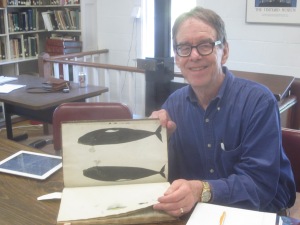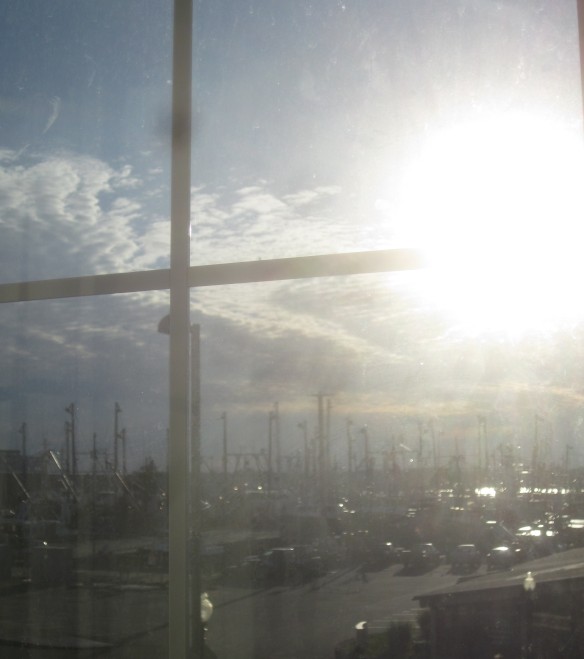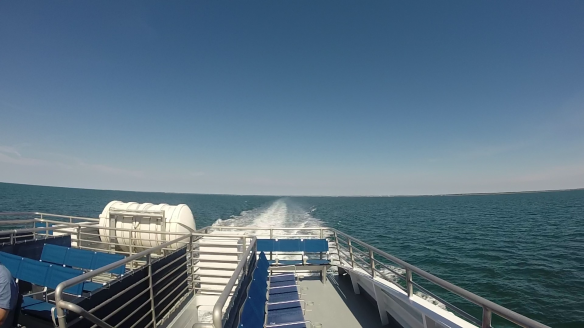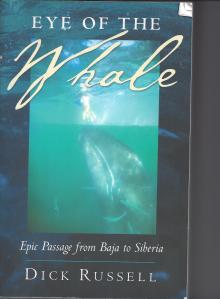Both the ferry landing and the street at Oak Bluff were full of people in vacation attire. The tourist season out here has definitely begun in earnest. At the third light pole we saw no terminal across the street, but we did see a big white bus from the Transit Authority. The ‘terminal” was a man in a wheelchair selling tickets, many of them the $7 day passes. Lesley got one too, as she had decided to go as far as Edgartown with us to see the Martha’s Vineyard Museum. The bus was entirely full as soon as we got on, our whale-ship gear sharing the aisle with those who came in after us. As soon as our driver stopped taking passengers, another bus came up and took those who were waiting.
What a lovely drive along the shoreline from Oak Bluff to Edgartown, a leafy road with overarching trees followed by a long, narrow, flat road which was all that separated the ocean on the left from a pond of deep blue water to the right (later identified on a map as Sencekontacket Pond). The city of Edgartown turned out to be big enough that I wondered a little about how far we might have to walk, with all our gear, from the bus stop. It turned out to be no problem: up Church one block to Main, a quick right on School Street, and three blocks down. We reached the museum shortly after 11, just as I had hoped from the 10:30 arrival of our ferry.
Bow Van Riper, the chief archivist, was away in the state of Ohio, but he had set aside what we had hoped to see and had prepared Nathaniel Jannick, one of his assistants, to greet us. Nathaniel brought me the log of the Morgan’s first voyage and he brought Vanessa a box of material relating to Laura Jernegan, the young Vineyarder who had gone whaling with her parents at age 6 (whose story had been the launching pad for the film Electric Oil by Vanessa’s friend Jessica Rinland). Vanessa sifted through that material quite quickly and spent the rest of the time before lunch under a tree reviewing the book about females who had tried to pass as male sailors on sailing ships in the eighteenth and nineteenth centuries (part of the inspiration for her project on the Morgan).
Lesley and I spent most of our time, before and after lunch, reading and taking notes from the log of the Morgan’s maiden voyage kept by second mate Francis C. Osborn. The log of the Morgan begins toward the end of the volume in which Osborn kept the log of the whale ship Alexander Barclay of New Bedford from 1837 to 1840. Francis Osborn writes very clearly. His logs are impressively legible. On the second page of the one for Morgan he repeats the whole first page, presumably to improve his handwriting.
In addition to his written entries, Osborn’s book has beautiful illustrations, placed so that one is not sure to which of the two voyages they refer. Inside the front and back covers are horizontal scenes on the vertical width of the page, somewhat crude in execution but quite visceral in their authenticity.
Much later in the book, where the log of the Alexander Barclay gives way to that of the Charles W. Morgan, Osborn has drawn an absolutely brilliant vertical composition of two whales in black and blue, the body and tail of the black one nested within the larger body of the blue, the tail of each a beautiful example of the “crescentic flukes” that Ishmael celebrates in his chapter on “The Tail.” In addition to the positioning of the shapes, there is the coloristic saturation and finesse of the deep blacks and iridescent blues, not only in the compound whales but in the bird flying in from the opposite page.
At the end of the volume, after the portion of the Morgan’s log in this book, Osborn created two beautiful portraits of full length right whales, each facing left but upside down from each other. Both of these amateur drawings by a whale ship mate are much more accurate than any of the drawings by scientific authorities that Ishmael satirizes in his chapter on “The Monstrous Pictures of Whales” in Moby-Dick.
Osborn also drew a chart in which the whaleboat he commanded (the right starboard boat) is accompanied by a vertical stacks of generic shapes which correspond to the number of whales his boat had killed. Each whale is accompanied by the number of barrels of oil that creature had yielded to the industry of the chase. I remember Mike Dyer saying he thought this book was one of the most beautiful log books he had ever seeen, and now I can see why.
After the Morgan had departed from New Bedford on September 6, 1841, its log book did not record its first kill—signaled by the stenciled image of a black sperm whale in the log—until December 16, more than three months later. The log of the voyage contained in this volume continues into the month of May, but Osborn records not another single kill. Nevertheless, the log is very interesting to read.
In Osborn’s hand the mundane aspects of the voyage attain a kind of folk purity. As Lesley knew from her study of other log books, Osborn is following certain traditionial tropes and formulas. I had noticed early on that Osborn often ends an entry with “So ends the day.” Then I began to see that he often personifies the day itself, as in the entry he begins with these words: “Wed. Jan. 26th comes with strong breezes from the SE.” By this time of the voyage, he ends most of his entries with “So ends,” knowing that the rest of the phrase would be completed in the mind of the reader.
Wednesday, January 12, 1841, “came in with pleasant weather.” The same day “So ends heading S. W.” In between, Osborn reports an exhausting morning, afternoon, and evening. “About 10 o’clock saw a large Sperm Whale. Lowered 4 Boats and Chased him untill one o’clock came in hand and got Dinner and then after again untill Night.” The next day they “saw Whales, Lowered and chaised until it was Dark,” again without success.
By noon Lesley and I had begun to savor the the rhythm and style of the log, so we took a break and joined Vanessa for lunch. We took the advice of Lara Ullman, the assistant of Bow who filled in for Nathaniel during his lunch. Her recommendation of Express Love, retracing our steps up School Street, was perfect. We found a shaded table out on the patio and had sandwiches and coffee in perfect weather in a relaxed conversation it would have been fine to continue all day. By one o’clock, however, I was eager to get back to the museum because Vanessa and I were to be taking the 2:12 bus from Edgartown to the Gay Head Lighthouse, and I was wanting to see as much as I could of the rest of the Morgan log book before we left.
The longer Lesley and I spent in the log the more we enjoyed it, especially afrer the ship rounded Cape Horn and began to “speak” with other vessels. In early February, the ship anchored for nearly a week off Callao, the port city of Lima, Peru. The locals were celebrating “Feast Days,” giving the Port and Starboard Watches, in alternation, plenty of opportunity to enjoy the pleasures of land. Lesley had been hoping to find some entries about the Australian islands at which her great-grandparents had entertained whalers, American and otherwise, but this portion of the Morgan’s log did not get anywhere near the western Pacific. Lesley nevertheless stayed on to read to the end of Osborn’s volume before returning on her own to board the Morgan in Vineyard Haven.
Vanessa and I continued on to Gay Head Lighthouse before taking another bus to Vineyard Haven for the 5 pm meeting with the rest of the 38th Voyagers. You can see the triangle of our day trip on the transit map below, running from Oak Bluff at the top right along the coast to Edgartown at the lower right before crossing horizontally to West Tisbury and then down to Gay Head at the far lower left corner before heading up through West Tisbury again to Vineyard Haven at the top center.






















